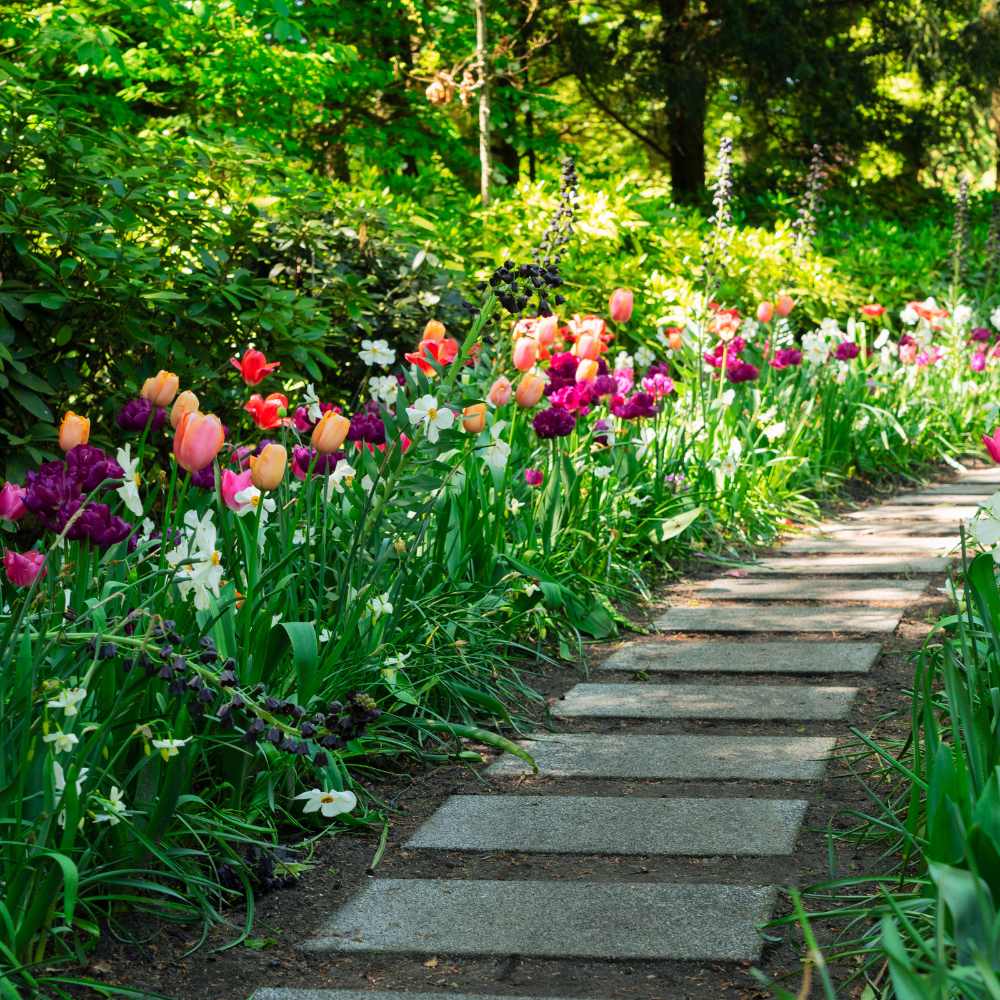A Beginners Guide on How to Grow Tulips
Whether you’re a seasoned gardener or just someone who loves a bright, cheerful bloom, tulips are a must-have in the spring garden and how to grow tulips is easy by following a few rules.

Where is the Best Place to Plant Tulips?
Tulips look best when planted as part of a group. In the above example, two different varieties of pink tulips have been underplanted with vivid blue forget-me-nots. The whole picture is completed (and dominated) by the vibrant pink of the azalea in the background. All the plants have been chosen to compliment each other and to flower at the same time. This is a sunny border, and tulips do best in full sun, so find the sunniest place in your garden and plant them there. Having said that, I grow varieties of tulips in a semi-shady spot and they do fine with less sun. The important thing to remember is the bulbs do like like getting soggy. If you have wet soil they will not thrive. You need to either improve your soil’s drainage by incorporating organic matter, such as compost and manure with horticultural grit, or grow them in pots.
What Mixes Well with Tulips?
Tulips look amazing when planted in swathes to grow through grass, perhaps edging a pathway running through with some late flowering daffodils, such as the Pheasants eye daffodil, also known and the Poet’s daffodil. You can extend the season by planting snowdrops and large crocus for early colour and alliums and cammassias for later colour. All are perfect for naturalising in grass.

How do you Make a Tulip Garden?
Tulips make wonderful combinations with other plants. Because there are so many varieties to choose from, it’s always possible to find a colour to match a planting scheme. In the example below, various varieties of tulips, from early to late flowering varieties, are mixed with grape hyacinths for early splashes of blue, with bearded iris, to give colour in June after the tulips have gone over.

What do you do With Tulips After they Bloom?
You’ll need to leave the leaves of the bulbs to die down naturally, this is important so they can regenerate for flowering the following year. It’s best to deadhead tulips, just as with other bulbs so the plant can put energy into the bulb and now the seed head.
How to Grow Tulips – What is the Best Month to Plant Tulips?

How to Grow Tulips – Can Tulips be Grown in Pots ?
Yes, Yes, Yes! Tulips make great plants to grow in a pot, container or raised bed. Growing tulips in a pot is perfect for filling gaps in borders or on your patio to give an ‘instant’ effect.


In the above example, Tulipa ‘ White Dream’ makes a dramatic contrast with the red wallflowers. This display can be changed throughout the year to give seasonal interest all year round.

Tulips are what’s known as a statement plant…because of their bright colours they are not shy background types, they steal the show! So…it pays off to choose the container you put them in with care. In the above example, the vibrant Tulipa ‘Golden Apeldoorn’ contrasts and compliments the darker colour of the container. Perfect for decorating a deck.
Should you lift tulips after flowering?
You don’t have to lift tulips once they have died back, but but if you want to keep changing the display, then yes, they can be lifted and stored. Once the foliage has browned off, dig up your bulbs shaking off excess soil. Store them in a dry, ventilated spot, a garage is ideal, spread over cardboard down and leave until ready to plant again in the autumn. Make sure all the bulbs are healthy, throw away anything that is soft or looks diseased as one damaged bulb can risk all the others.
How to grow Tulips – Planting
Tulips don’t like wet soil so use a well-draining compost and be generous with the amounts of bulbs you use, more than you would if you were planting them in a border. Fill your pots two thirds full with compost, and lay the bulbs, point up about 5cm apart.
If you need help choosing or planting your bulbs, we offer a bulbs planting service with our skilled horticultural team from September to early December. If you would like some help and live in the Oxfordshire area contact our team here!
Before planting anything, I would advise you to take a look at the plant growing in another garden. Look at the combinations of plants that appeal to you and copy the idea. There’s a good display of tulips at Oxford’s Botanical garden, a peaceful little oasis, situated near Magdalen Bridge. The best month to plant tulip bulbs is November, so you have lots of time to make a selection. Your future spring self will thank you!
